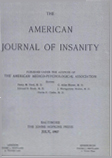Abstract
Brain potentials can be used within limits as an index of the action of cerebral neurones. The recorded waves are the envelope of the beats of many single neurones and their profile depends on the shape of the unit potential and the temporal relation of the many units.
The isolated frog brain, with relatively few and similar neurones which can be subjected to a wide variety of experimental conditions, is especially favorable for studying the control of potentials. Mammalian brain in situ, so far as similar experiments have been made, shows like behavior.
The olfactory bulb of the isolated brain gives an electrical beat, at six per second, larger and more regular than before removal from the frog. Under varied conditions, the frequency, still regular, may be shifted from one to 50 per second and the single wave from a sine to many highly skewed forms constantly repeated. Such patterns indicate strong unison of the many cells and so reproduce the potential profile of the unit.
The unit beat is controlled by the metabolism of the cell, oxidative or glycolytic energy supplying the driving force. It is also controlled by a trip mechanism, presumably the cell membrane, which determines the frequency of oscillation at constant drive. Amplitude and frequency vary inversely as the trip mechanism is altered, together as metabolism is changed.
Control of cell potentials mainly through metabolism is considered in the cases of: oxygen lack, narcosis, cyanide, glucose lack, insulin, B1 avitaminosis, iodoacetate, and nicotine poisoning. The action and interaction of these and subsequent agents is presented.
Control mainly through the trip mechanism is considered for: altered osmotic pressure, sodium, potassium, calcium, magnesium, and hydrogen ions; for neural stimulation and, in more detail, for polarization by constant currents.
Unification of the beats of the many units into synchronous or simultaneous patterns must depend on the propagation of nerve impulses or on electric fields and currents. The mechanism of unification is analyzed and tests for its effectiveness are described. The following conditions favor unison: high temperature and calcium, low potassium and sodium, diminution in afferent nerve impulses (in patterns), increased polarization (or injury potentials), the drugs nicotine and caffeine.
Further analysis is made with caffeine, which leads to large repeated waves which may travel along the hemisphere. These are described in detail; and also the control of their size, shape, frequency, speed, and direction of travel by temperature and polarization.
The spreading caffeine waves are not stopped by nicotine, which blocks synaptic conduction; they cross a complete transection of the hemisphere when the two halves are in good apposition and so in electrical but not neural continuity; and a caffeinized brain can augment the activity of an abutting normal one.
It is concluded that, besides neural coordination of separate neurons, a strictly electrical mechanism can regulate nerve cell beats and cause a spreading activation. This may prove of considerable importance in the interpretation of normal activity, electronarcosis, and of the massed "convulsive" action of the cortex in epilepsy.
A theoretical explanation of the mechanism of spread is presented. It demands the existence in brain of maintained polarization gradients in certain directions. These have been found present as predicted.

